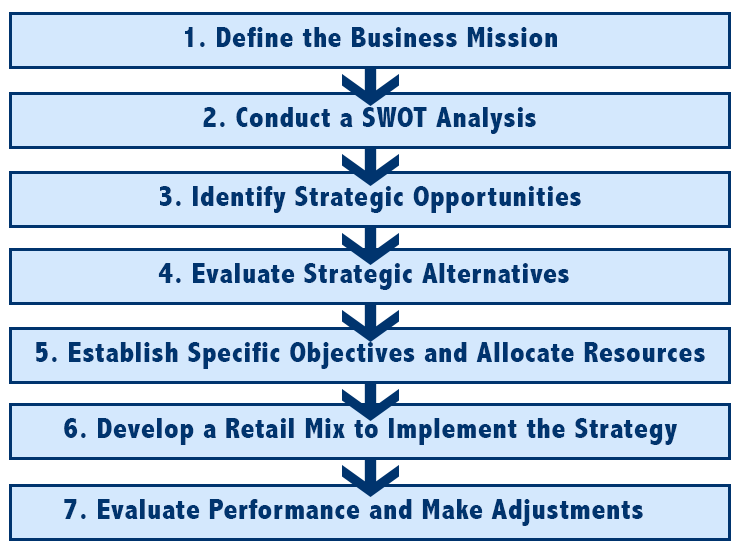Main Content
Lesson 2: Retail Strategic Planning
The Strategic Retail Planning Process
Just like Wayne Gretzky in hockey, retailers have to be forward-thinking. They must adapt their organization's or store's resources to the problems and opportunities of the world around them. See Chapter 5 in the textbook for a complete review of the seven steps retailers typically take to accomplish this (also shown in Figure 2.1).

Questions to Ask in the Strategic Planning Process
When conducting the strategic planning process, retailers need to be asking several questions:
- What business are we in? For example, do hospitals (retailers of health care services) only treat the sick? Or are they in the business of preventive medicine, too? What about Disney? Is it a media creator, a vacation resort, or a toy company?
- What will our business be in the future? Consider the Internet and mobile technology: Will they alter or change the business? Video-rental retailers went bankrupt due to a variety of competitive alternatives, such as Netflix, Redbox, and pay-per-view videos on cable. Think about streaming TV and how it has cut into cable subscriptions. One of my favorite things to do is binge watch old TV series or start watching new ones, such as the cop drama Bosch on Amazon Prime. Did you know that this new practice of watching television is defined by Netflix as watching two to six episodes of the same show in one sitting?
- Who are our customers? Retailers must consider the demographics and psychographics of their target audiences. Is the retailer’s target market one specific demographic (such as men for Men’s Wearhouse)? Or is it several demographics (such as a hairstylist who serves old and young, men and women, adults and kids alike)? Go to the website for Dr. Comfort and see the Men's Athletic Shoe. Who are their customers? Probably not a website you would buy from, am I right?
- What are our capabilities? Recall Anders and Stern's (2004) suggestion that retailers need to be the best at something. Maxine Clark, founder of Build-A-Bear, wrote a book titled The Bear Necessities of Business (2006). Like Anders and Stern, Clark contends that retail marketing strategies must focus on the five pillars of success:
- price,
- convenience,
- product,
- customer service, and
- overall experience.
To be viable and competitive, companies must have some capability in each of the categories. Prices must be set so that customers perceive value when comparing their offering to the competition. Some level of convenience must be extended to customers so that it's easy for them to do business with the company. (For example, hours of operation must meet the needs of busy families and working mothers.) Products must be desirable, something that customers want and believe they need. The level of customer service offered must be what customers expect. Clark’s last category is overall experience; for customers to continue to patronize a retailer, they must walk away from the purchase or service encounter with an overall favorable experience. These same principles should apply to online retailers as well as brick-and-mortar retailers.
- What do we want to accomplish? Goals must be set for strategic planning to be successful. Retailers need a target—clearly set goals with a strategy to achieve them. REI, an outdoor gear and apparel retailer that focuses on sustainable business operations, lays out specific initiatives that it plans to accomplish on its Sustainable Operations website:
- greenhouse gas emissions reduction (climate-neutral operations by 2020);
- managing energy use while growing the business, becoming a zero waste-to-landfill organization by 2020;
- mindful paper usage and sustainable forestry;
- green building; and
- product sustainability disclosure and rectification of product impact.
 Dunkin' Donuts: Name Change and Greener Retail Practices
Dunkin' Donuts: Name Change and Greener Retail Practices
In an effort to stay flexible and stay relevant to a broader consumer audience, Dunkin Donuts changed its name to "Dunkin." At the same time they made a new commitment to greener retail practices. In 2018 Dunkin Donuts announces to ditch foam cups for paper (Angulo, 2018).
- Their greener goal was to eliminate foam cups worldwide by 2020. Have you been to a Dunkin lately?
- The Dunkin in my hometown only uses paper cups. How about yours?
- How about the name change? Are you likely to consider Dunkin for other meals - not just breakfast?
References
Anders, W., & Stern, N. (2004). Winning at retail: Developing a sustained model for retail success. Hoboken, NJ: John Wiley & Sons, Inc.
Angulo, I. (201=8, February 7). Dunkin' Donuts aims to ditch foam cups for paper by 2020. Retrieved from https://www.cnbc.com/2018/02/07/dunkin-donuts-aims-to-ditch-foam-cups-for-paper-by-2020.html
Clark, M. (2006). The bear necessities of business: Building a company with heart. Hoboken, NJ: John Wiley & Sons, Inc.
